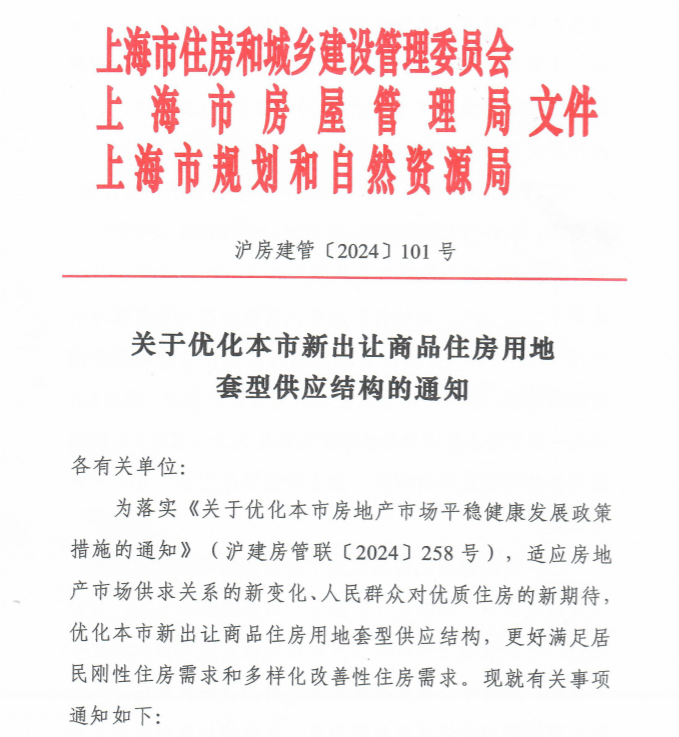Big moves in the first-tier property market
![]() 08/28 2024
08/28 2024
![]() 438
438
Text/Leju Finance Wang Min
Shanghai requires new policies for small and medium-sized housing, ending the long-running "7090 Policy"...

The Shanghai Housing and Urban-Rural Development Commission, the Housing Authority, and the Planning and Resources Bureau jointly issued a notice on optimizing the supply structure of residential unit types for newly assigned commercial housing land in the city.
The notice mentions that in terms of optimizing the floor area standards for small and medium-sized housing, the new land market policies in Shanghai will adjust the floor area standards for small and medium-sized housing in multi-story, small high-rise, and high-rise buildings to 100 square meters, 110 square meters, and 120 square meters, respectively, based on factors such as Shanghai's per capita housing floor area, family demographics, market demand for housing unit types, and housing architecture and construction conditions.
Regarding optimizing the supply ratio of small and medium-sized housing units on newly assigned commercial housing land, in principle, the ratio should not be lower than 70% in areas between the inner and outer rings, 60% within the inner ring, 60% in key areas of transformation in the north and south of the city, and 50% in other areas outside the outer ring. The notice also stipulates that 5% of the land assigned for various types of new commercial housing should be used for affordable housing, and 15% for self-held rental housing, which will be included in the overall planning of housing unit types.
Additionally, the notice allows for flexibility in adjusting the unit types based on market demand and the applicability of housing unit adjustments outlined in the "Work Opinions on Further Improving the Implementation and Deepening of Detailed Planning in Shanghai," in conjunction with overall implementation plans.
Furthermore, Shanghai has announced enhanced regional coordination in the unit type structure of newly assigned commercial housing land.
Some analysts believe that the increase in the recognized floor area for small and medium-sized housing and the reduction in the required ratio under Shanghai's new policy clearly favor upgrading housing demands.
Yan Yuejin, Deputy Dean of the E-house China R&D Institute, said that the policy underscores Shanghai's focus on changes in supply and demand and upgrading housing needs, while also addressing the "people, land, housing, money" model, thereby further relaxing and guiding unit type policies.
After this policy adjustment, Shanghai's small and medium-sized housing units will have larger floor areas, which means more large-sized residential units will enter the city's real estate market, better satisfying upgrading housing demands.
Yan noted that for high-rise residential buildings with more than 10 floors, the previous standard for small and medium-sized units was 100 square meters, but it is now 120 square meters, an increase of 20 square meters.
It is worth noting that signs of policy adjustments emerged as early as April this year.
In Shanghai's second round of land auctions in the first batch of the year, the "Design and Construction Standards for Small and Medium-Sized Housing" were adjusted to: multi-story residential buildings with a floor area of no more than 100 square meters, small high-rise residential buildings with a floor area of no more than 110 square meters, and high-rise residential buildings with a floor area of no more than 120 square meters.
Yan emphasized that unlike previous instances, Shanghai has officially issued this policy in the form of a document.
Yan believes that this new policy indicates that more housing units with larger floor areas will be introduced in future new housing construction designs, objectively better meeting the needs of different levels.
Previously, Shanghai's "Design and Construction Standards for Small and Medium-Sized Housing" were based on the "Several Opinions on Implementing the Requirements for the Proportion of Newly Constructed Housing Structures" issued by relevant departments in China in 2006. This policy stipulated that the proportion of housing units with a floor area of less than 90 square meters (including affordable housing) must account for more than 70% of the total area of newly approved and newly started commercial housing projects. This policy is also known as the "7090 Policy."
Under the "7090 Policy," Shanghai's previous "Design and Construction Standards for Small and Medium-Sized Housing" were mainly: multi-story residential buildings with a floor area of no more than 90 square meters, small high-rise residential buildings with a floor area of no more than 95 square meters, and high-rise residential buildings with a floor area of no more than 100 square meters.
Industry insiders believe that this policy also indicates the official easing of Shanghai's long-standing "7090 Policy."
In March of this year, online rumors circulated that the Shenzhen Planning and Natural Resources Bureau issued a notice announcing the cessation of implementing the "Notice on Implementing the Requirements for the Proportion of Residential Unit Types in Accordance with National Policies.""Regarding the above policy adjustments, the Shenzhen Planning and Natural Resources Bureau confirmed that the contents of the document are true. This move indicates the official withdrawal of the "7090 Policy" in terms of unit type proportions in Shenzhen.
In other words, among first-tier cities, after Shenzhen stopped implementing the "7090 Policy," Shanghai has also officially withdrawn from it.
Yan believes that for homebuyers, one of the important criteria for a good house is spaciousness and comfort. Shanghai's new policy not only leads the new trend of national real estate development but also demonstrates Shanghai's continued efforts to pursue high-quality housing products.
A real estate analyst pointed out that Shanghai's latest policy represents a new trend in the national real estate industry, with housing products continuing to strive for quality. It is expected that there will still be room for coordination and optimization during future policy implementation.
Industry insiders also believe that the easing of policies in Shenzhen and Shanghai and the withdrawal of the "7090 Policy" from the historical stage have ushered in a new direction for the market.





